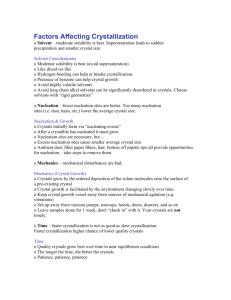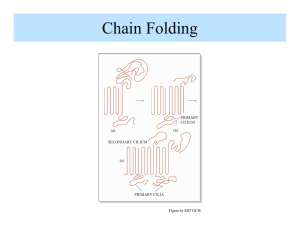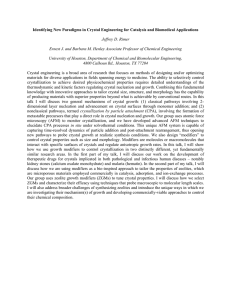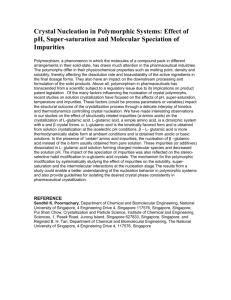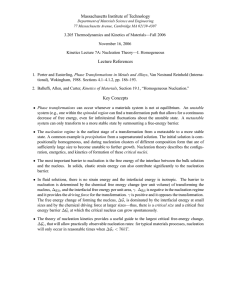Temperature effects for isothermal polymer crystallization kinetics Giridhar Madras
advertisement
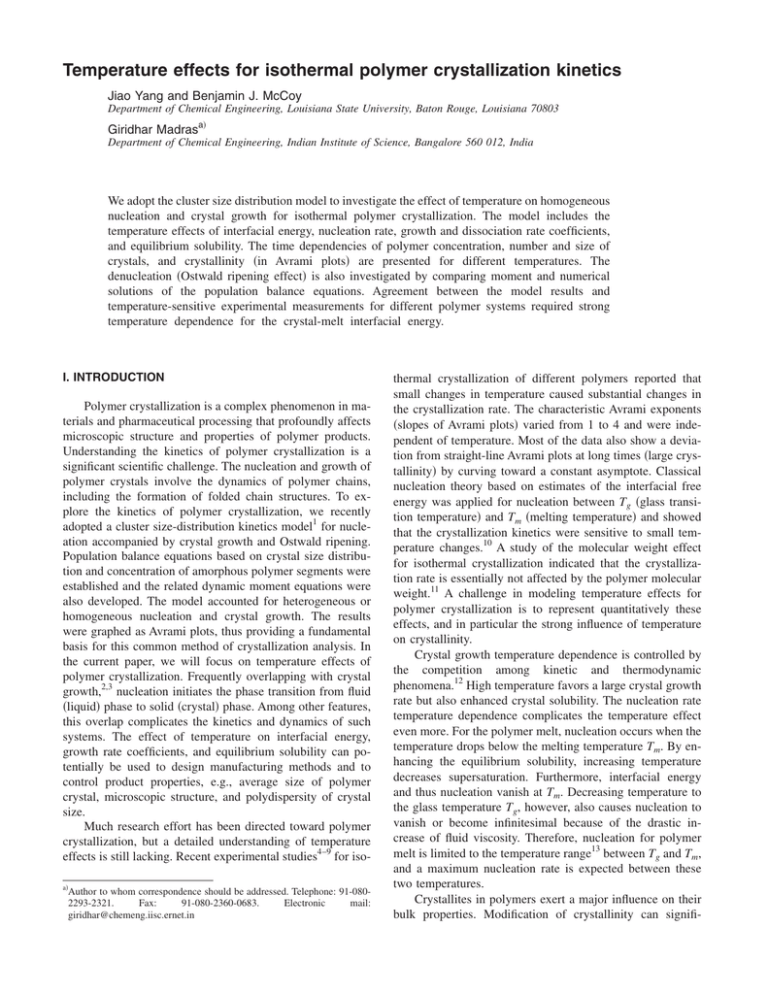
Temperature effects for isothermal polymer crystallization kinetics Jiao Yang and Benjamin J. McCoy Department of Chemical Engineering, Louisiana State University, Baton Rouge, Louisiana 70803 Giridhar Madrasa兲 Department of Chemical Engineering, Indian Institute of Science, Bangalore 560 012, India We adopt the cluster size distribution model to investigate the effect of temperature on homogeneous nucleation and crystal growth for isothermal polymer crystallization. The model includes the temperature effects of interfacial energy, nucleation rate, growth and dissociation rate coefficients, and equilibrium solubility. The time dependencies of polymer concentration, number and size of crystals, and crystallinity 共in Avrami plots兲 are presented for different temperatures. The denucleation 共Ostwald ripening effect兲 is also investigated by comparing moment and numerical solutions of the population balance equations. Agreement between the model results and temperature-sensitive experimental measurements for different polymer systems required strong temperature dependence for the crystal-melt interfacial energy. I. INTRODUCTION Polymer crystallization is a complex phenomenon in materials and pharmaceutical processing that profoundly affects microscopic structure and properties of polymer products. Understanding the kinetics of polymer crystallization is a significant scientific challenge. The nucleation and growth of polymer crystals involve the dynamics of polymer chains, including the formation of folded chain structures. To explore the kinetics of polymer crystallization, we recently adopted a cluster size-distribution kinetics model1 for nucleation accompanied by crystal growth and Ostwald ripening. Population balance equations based on crystal size distribution and concentration of amorphous polymer segments were established and the related dynamic moment equations were also developed. The model accounted for heterogeneous or homogeneous nucleation and crystal growth. The results were graphed as Avrami plots, thus providing a fundamental basis for this common method of crystallization analysis. In the current paper, we will focus on temperature effects of polymer crystallization. Frequently overlapping with crystal growth,2,3 nucleation initiates the phase transition from fluid 共liquid兲 phase to solid 共crystal兲 phase. Among other features, this overlap complicates the kinetics and dynamics of such systems. The effect of temperature on interfacial energy, growth rate coefficients, and equilibrium solubility can potentially be used to design manufacturing methods and to control product properties, e.g., average size of polymer crystal, microscopic structure, and polydispersity of crystal size. Much research effort has been directed toward polymer crystallization, but a detailed understanding of temperature effects is still lacking. Recent experimental studies4–9 for isoa兲 Author to whom correspondence should be addressed. Telephone: 91-0802293-2321. Fax: 91-080-2360-0683. Electronic mail: giridhar@chemeng.iisc.ernet.in thermal crystallization of different polymers reported that small changes in temperature caused substantial changes in the crystallization rate. The characteristic Avrami exponents 共slopes of Avrami plots兲 varied from 1 to 4 and were independent of temperature. Most of the data also show a deviation from straight-line Avrami plots at long times 共large crystallinity兲 by curving toward a constant asymptote. Classical nucleation theory based on estimates of the interfacial free energy was applied for nucleation between Tg 共glass transition temperature兲 and Tm 共melting temperature兲 and showed that the crystallization kinetics were sensitive to small temperature changes.10 A study of the molecular weight effect for isothermal crystallization indicated that the crystallization rate is essentially not affected by the polymer molecular weight.11 A challenge in modeling temperature effects for polymer crystallization is to represent quantitatively these effects, and in particular the strong influence of temperature on crystallinity. Crystal growth temperature dependence is controlled by the competition among kinetic and thermodynamic phenomena.12 High temperature favors a large crystal growth rate but also enhanced crystal solubility. The nucleation rate temperature dependence complicates the temperature effect even more. For the polymer melt, nucleation occurs when the temperature drops below the melting temperature Tm. By enhancing the equilibrium solubility, increasing temperature decreases supersaturation. Furthermore, interfacial energy and thus nucleation vanish at Tm. Decreasing temperature to the glass temperature Tg, however, also causes nucleation to vanish or become infinitesimal because of the drastic increase of fluid viscosity. Therefore, nucleation for polymer melt is limited to the temperature range13 between Tg and Tm, and a maximum nucleation rate is expected between these two temperatures. Crystallites in polymers exert a major influence on their bulk properties. Modification of crystallinity can signifi- cantly alter mechanical and optical properties. Thus, the thermal history of a polymer, in particular between Tg and Tm, greatly influences its end-use value.14 Understanding the temperature effect, the key parameter influencing industrial crystallization, is essential for rational manufacturing design and operation. Potentially one can exploit the competition between kinetics and thermodynamic driving forces to manipulate the crystallization rate, crystal size, and particle polydispersity. Our approach is to represent the dynamics and kinetics of nucleation and growth processes by a cluster size-distribution model. The temperature effect is incorporated into the model by considering the temperature dependence of interfacial energy, equilibrium solubility, and growth rate coefficient. We begin in the next section by reviewing the theory of nucleation, growth, and coarsening for polymer crystallization. In a following section, quantitative results of the theory are presented and discussed, along with comparison with published experimental data. Conclusions are presented last. lamellae. The energy W共a兲 of a cluster increases with a and then decreases from the maximum value W* at the critical lamellar length, a* = 2xm/共RT ln Ssat兲. 共2兲 According to the similarity of thermodynamic driving-force expressions for nucleation from polymer solution and polymer melt,19–21 the supersaturation Ssat can be written in terms 共0兲 of number of free macromolecules m共0兲 and meq , Ssat 共0兲 共0兲 = m / meq , instead of melting enthalpy and temperature driving force. Thus, the maximum energy of the cluster is represented as 共0兲 兲兴. W* = 4xmb2/RT关ln共m共0兲/meq 共3兲 The nucleation rate, according to classical homogeneous nucleation theory, is the flux over the maximum energy barrier 共at a = a*兲, I = kn exp共− W*/RT兲, 共4兲 with prefactor17 kn = 共m共0兲兲2共2xm/兲1/2−1 . II. THEORY Temperature influences nucleation and crystal growth in polymer processing through kinetics and thermodynamics. As polymer melt or solution is cooled, the molecule tends to move toward the lowest energy conformation, leading to the formation of ordered chains.15 Chain entanglement, however, impedes the ordering required for nucleation. As the polymer solution or melt is cooled, diffusion coefficients decrease. When cooled to the glass transition temperature Tg, the polymer solution or melt becomes glassy and nucleation is totally quenched because no molecules are able to overcome the diffusion resistance to aggregate and align into a nucleus. The growth of the crystalline region is also impeded by reduced diffusion at low temperature and thermal redispersion of the chains at the crystal/melt surface at higher temperature. Temperature effects on nucleation rate, according to the classic nucleation theory,16 originate from the interfacial energy difference and equilibrium solubility change at various temperatures. Temperature influences incorporated in crystal growth rate include the prefactor of growth rate coefficient, the Gibbs–Thomson effect of particle curvature,17 and the phase transition energy 共heat of solidification兲. The dissociation rate coefficient is related to the growth rate coefficient by microscopic reversibility, thereby determining its temperature dependence. For a two-dimensional 共2D兲 equilateral lamellar crystal, according to classical homogeneous nucleation theory, the sum of surface energy and formation free energy can be represented as1,18 W共a兲 = 4ab − a2b共/xm兲RT ln Ssat , 共1兲 where −RT ln Ssat is the chemical potential difference between the two phases in terms of the supersaturation, Ssat, the ratio of bulk concentration m共0兲 over equilibrium concentra共0兲 tion meq . Also, is the crystal interfacial energy, is the density of the cluster, xm is the molecular weight of the monomer, a is the lateral length, and b is the thickness of the 共5兲 Thermodynamics provides the temperature dependence of solubility for the corresponding flat surface, m⬁共0兲 = ⬁ exp共−⌬H / RT兲, where ⌬H represents the molar energy of phase transition between solid 共crystal兲 phase and liquid phase, and ⬁ stands for the flat-surface polymer solubility at high temperature. The temperature dependence of interfacial energy is approximated by22 = 0共1 − T/Tm兲n , 共6兲 causing interfacial energy to vanish at reference temperature Tm. For n = 0 or 1, is constant or linearly decreasing, respectively.22 But for n ⬇ 20, falls sharply for T Ⰶ Tm, and then decreases gradually to zero as T approaches Tm. For the present model, this dependence of interfacial energy on T is critical for explaining the temperature dependence of polymer crystallinity. Similar to cluster growth in the kinetics model of McCoy,23 crystal growth can be considered as the gradual building up of polymer molecules on the surface of the nucleus in a melt or solution. A general representation of the reversible deposition of chain segments on the crystal surface is kg共x兲 C共x兲 + M共xm兲 C共x + xm兲, kd共x兲 共7兲 where C共x兲 represents the cluster of mass x and M共xm兲 is the polymer of uniform molecular weight xm with a distribution written as m共x , t兲 = m共0兲␦共x-xm兲. The mass-dependent rate coefficients kg共x兲 and kd共x兲 are for cluster growth and dissociation, respectively. An activation energy for the growth coefficient accounts for its temperature dependence, kg共x兲 = ␥x exp共− E/RT兲. 共8兲 The exponent can be set equal to 0, 1 / 3, and 2 / 3, representing surface independent, diffusion controlled, and surface dependent growth rate.18 A number larger than 2 / 3 is also occasionally suggested,1,24 for the increasing mass dependence of deposition rate caused by microstructure changes or shear force during fluid movement. The rate coefficient for dissociation is simply related to kg共x兲 by microscopic reversibility, kd共x兲 = 共0兲 meq kg共x兲. 共9兲 For a lamellar crystal with flat growth front, the Gibbs– Thomson effect vanishes, so that the difference between lo共0兲 cal equilibrium interfacial concentration meq and solubility 共0兲 共0兲 m⬁ for a flat surface vanishes, thus meq = m⬁共0兲. The population balance equations that govern the distributions of crystals and macromolecules are25 c共x,t兲/t = − kd共x兲c共x,t兲 + 冕 ⬁ − xm兲兲dx⬘ − kg共x兲c共x,t兲m + m共0兲 冕 共0兲 冕 ⬁ ␦共x⬘ − xm兲dx⬘ 0 x kg共x兲c共x⬘,t兲␦共x − xm兲dx⬘ 0 + I␦共x − x*兲, 共10兲 and 共0兲 m共x,t兲/t = m 共t兲 + 冕 冕 ⬁ kg共x⬘兲c共x⬘,t兲dx⬘ kd共x⬘兲c共x⬘,t兲␦共x − xm兲dx⬘ x − I␦共x − x*兲x*/xm . 共11兲 Consistent with the definition of rate coefficients in Eq. 共7兲, the population balance equations are based on concentration units of mole/volume. We define dimensionless quantities as follows:26 C = cxm/⬁, n c共n兲 = c共n兲/⬁xm , = t␥⬁xm , S = m共0兲/⬁ , ⌰ = T/Tm, = E/RTm, dC共0兲共兲/d = J, 共14兲 dC共1兲共兲/d = − exp共− /⌰兲关− S共兲 + exp共− h/⌰兲兴C共0兲 − J* . 共15兲 Here J represents the scaled homogeneous nucleation rate of crystal of critical mass size * and is a source term in Eqs. 共13兲–共15兲. The number of macromolecules in the critical crystal nucleus is 共16兲 which varies with time, because of the time dependence of the scaled number of crystallizing polymers S, and is strongly dependent on temperature. The initial conditions are S共 = 0兲 = S0 and C共0兲共 = 0兲 = 0 for homogeneous nucleation. For a batch system without agitation, crystallizing temperature is the only operating condition. In terms of the initial number of polymer molecules S0, the scaled mass conservation for a closed system follows from the population balance equations, Eqs. 共13兲 and 共15兲, 共17兲 where C共1兲 0 is the initial cluster mass, representing heterogeneous nuclei and seeds, and is zero for homogeneous nucleation, and S0 is the initial number of polymer molecules. At thermodynamic equilibrium, supersaturation Ssat equals unity, so that the thermodynamic driving forces for crystal growth and nucleation rate vanish. Thus the time evolution rates of moments are zero, dS共兲 / d = 0 and dC共0兲共兲 / d = 0. The degree of crystallinity, X, is defined as the ratio of the mass crystallized at time t divided by the total mass crystallized, 共1兲 共1兲 X = 共C共1兲 − C共1兲 0 兲/共Ceq − C0 兲. = x/xm , w = 20共xmb/兲1/2/RTm, and C共1兲共兲 + S共兲 = C共1兲 0 + S0 , 0 ⬁ 共13兲 * = 关w共1 − ⌰兲n/⌰共ln S + h/⌰兲兴2 , kd共x⬘兲c共x⬘,t兲␦共x − 共x⬘ x dS共兲/d = exp共− /⌰兲关− S共兲 + exp共− h/⌰兲兴C共0兲 + J* 共18兲 Substitution of the mass conservation equation, Eq. 共17兲, simplifies Eq. 共18兲 to J = I/␥⬁2 xm , 共12兲 h = ⌬H/RTm , where numbers of polymer molecules and polymer crystals, S and C共0兲, are scaled by solubility at high temperature ⬁. 共0兲 The supersaturation, Ssat = m共0兲 / meq = S exp共h / ⌰兲, evolves to unity at thermodynamic equilibrium. The temperature is scaled by a reference temperature Tm, the melting temperature of polymer crystal. The interfacial energy, = w共1 − ⌰兲n / ⌰, is expressed in terms of scaled temperature ⌰ and the temperature-independent parameter w. With the definition of the nth moment, C共n兲 = 兰⬁0 xnC共x , 兲dx, for the special case = 0 the dimensionless population balance equations for crystal growth and nucleation can be represented as moment equations, X = 共S0 − S共兲兲/共S0 − e−h/⌰兲 ⬇ 1 − S/S0 , 共19兲 where at equilibrium, consistent with Eq. 共13兲, Ssat = 1 and S = e−h/⌰ ⬇ 0, for h Ⰷ ⌰. By defining the temperatureindependent prefactor, −1/2 , J0 = 共20/兲1/2/␥xm 共20兲 the nucleation rate can be written as J = J0共1 − ⌰兲n/2S2 exp关− 共w共1 − ⌰兲n/⌰兲2/共ln S + h/⌰兲兴. 共21兲 The growth and dissociation rate coefficients are assumed to be mass independent 共 = 0兲 in the above moment method. However, these rate coefficients are not always mass independent, especially for polymer solutions with high viscosity. A more general expression for the mass dependence is FIG. 1. Time evolution of 共a兲 number of macromolecules S, 共b兲 average cluster size Cavg, 共c兲 nucleation rate J, and 共d兲 −ln共1 − X兲 at ⌰ = 0.970, 0.972, 0.974, and 0.976 with parameters given in Table I. the power law18 dependence in Eq. 共8兲. With the dimensionless quantities of Eq. 共12兲, Eqs. 共10兲 and 共11兲 can be written as dS共兲/d = exp共− /⌰兲关− S共兲 + exp共− h/⌰兲兴C共兲 + J* 共22兲 and C共, 兲/ = S共兲exp共− /⌰兲共− C共, 兲 + 共 − 1兲C共 − 1, 兲兲 − exp共− 共 + h兲/⌰兲C共, 兲 + 共 + 1兲 exp共− 共 + h兲/⌰兲C共 + 1, 兲 − J␦共 − *兲. 共23兲 Here, C共 , 兲 / represents the generation rate of clusters with polymers. Numerical schemes are employed to solve the equations. III. RESULTS To grasp the temperature dependence of the whole process of crystallization, it is important to understand the temperature dependence of the two overlapping processes:2 nucleation and crystal growth. Temperature influences nucleation rate, according to Eq. 共21兲, mainly through supersaturation, Ssat = S exp共h / ⌰兲, and interfacial energy, = 0共1 − ⌰兲n. The nucleation rate decreases near the melting temperature because of the substantial temperature dependence of interfacial energy there. Crystal growth rate, influenced by temperature mainly through the growth activation energy according to Eq. 共8兲, increases with temperature. We are initially concerned with the effect of temperature on the time evolution of crystal size distribution. Figure 1 presents the temperature effects on number of macromolecules, crystal number, crystal size, and nucleation rate at different temperatures close to the reference temperature Tm. Based on experi- mental measurements,27 reasonable parameter values are chosen, as listed in Table I. The mass dependence of growth rate coefficient is chosen to be 0, thus the moment equations 共13兲–共15兲 are applied to describe nucleation and crystal growth. Considering the sensitivity of crystallinity on temperature, the scaled temperature values ⌰ are chosen to be 0.970, 0.972, 0.974, and 0.976. Figure 1共a兲 shows the time evolution of polymer concentration, with a larger decrease speed of S at the lower temperature, ⌰ = 0.97. Decreasing temperature speeds up nucleation, and the crystal growth rate decreases slightly because of the lower temperature sensitivity for crystal growth. The time evolution of crystallized mass concentration, not presented in this paper, is simply a mirror image of S according to Eqs. 共13兲 and 共15兲. The temperature effect on average crystal size is presented in Fig. 1共b兲. The average crystal size increases with time by crystal growth and later does not change very much as equilibrium is approached. Increasing temperature also increases the average crystal size. According to the definition, Cavg = C共1兲 / C共0兲, the decline of average crystal size results either from the increase of the number of crystals, C共0兲, or from the decrease of crystallized mass, C共1兲. As temperature drops, the nucleation rate drops according to Eq. 共21兲, and more particles are generated per unit time, as given by Eq. 共14兲. The crystal mass concentration, according to Eq. 共15兲, grows more slowly because of the decrease of growth rate coefficient at low temperature. The time evolution of nucleation rate 关Fig. 1共c兲兴 is caused by the decline of supersaturation due to crystallizaTABLE I. Parameter values in figures 共unless otherwise noted in captions兲. C共0兲 0 C共1兲 0 S0 J0 w h n 0 0 10 106 0 2.0 1.0 100 20 FIG. 2. Effect of temperature dependence of interfacial energy with ⌰ = 0.97 and other parameters given in Table I. FIG. 4. Effect of phase transition enthalpy h with ⌰ = 0.97 and other parameters given in Table I. tion. The nucleation rate drops quickly because of the sharp decrease of supersaturation. As the supersaturation decreases, the energy barrier for nucleation, W*, tends to increase, thus the nucleation rate, according to Eq. 共4兲, will decrease. The temperature effect on nucleation rate is also confirmed in Fig. 1共c兲. Initially a substantial nucleation rate decrease is observed when the temperature varies from 0.970 to 0.976. Then nucleation is quenched at the end of crystallization as the supersaturation Ssat approaches unity. The characteristic Avrami plots are presented in Fig. 1共d兲, and a larger crystallization rate is observed at lower temperature. The Avrami exponents at the four temperatures 共the slopes of the characteristic Avrami plots兲 are around 1.95, independent of the temperature. The Avrami exponent is hardly affected by temperature near Tm. The effect of n, the temperature power dependence for interfacial energy, is presented in Fig. 2. The temperature sensitivity of crystallization is strongly dependent on n. When n is small, crystallization rate does not change much with temperature, thus large n 共⬇20兲 is suggested here. According to Eqs. 共3兲 and 共6兲, increasing n will raise the energy barrier for nucleation and thus decrease the nucleation rate. We observed a large difference in crystallization rate for a small difference in n, as shown in Fig. 2. We also find that n has little influence on Avrami exponents. The investigation of the activation energy in the growth rate coefficient kg is presented in Fig. 3. The value of is chosen to vary from 0.1 to 3 with ⌰ = 0.97 and other parameters given in Table I. No apparent slope difference is observed in the characteristic Avrami plots; thus, varying does not influence the value of Avrami exponents. According to Eq. 共8兲, the increase of will lead to the decline of crystal growth rate coefficient, and a larger overall crystallization rate is indeed observed when is small. Despite more than one order of magnitude change in the value of , however, the influence of this parameter on the time evolution of the crystallization is not as much as n. The enthalpy of phase transition, h, is another parameter included in our distribution model for isothermal crystallization. According to experimental measurements,4,10 ⌬H is around 300 kJ/ mol for most polymers, so that h is about 100. To explore the effect of phase transition enthalpy, we chose a wide range of h, varying from 0.1 to 1000, in Fig. 4. We observe no kinetics contribution from the h variation because exp共−h / ⌰兲 in Eqs. 共13兲 and 共15兲 is quite small and S is the dominant term in the equations. Thus, the crystallization rate does not change much for large values of h. The nucleation rate prefactor, J0, according to Eq. 共20兲 is related to interfacial energy, density, and polymer molecular weight; thus different nucleation rate prefactors are expected for different polymer systems. The investigation of the effect of nucleation prefactor is presented in Fig. 5. As is evident FIG. 3. Effect of activation energy with ⌰ = 0.97 and other parameters given in Table I. FIG. 5. Effect of nucleation rate prefactor J0 with ⌰ = 0.97 and other parameters given in Table I. FIG. 6. Effect of denucleation at different nucleation rates with ⌰ = 0.9 and other parameters given in Table I. The dotted lines denote the moment solutions while the solid lines represent the numerical solutions. from Eqs. 共14兲–共16兲, increasing J0 speeds the growth rate and the onset of nucleation, resulting in a larger number of crystals. Shorter crystallization times are therefore required to reach the final state when the nucleation rate prefactor is large, as shown in Fig. 5. For Avrami plots, varying J0 causes only a lateral shift in . The nearly linear relationship between log关−ln共1 − X兲兴 and log allows only an order of magnitude lateral shift in as J0 is increased by two orders of magnitude. Denucleation, the reverse of nucleation, occurs when the crystal size is smaller than the critical crystal size. Denucleation has considerable influence on the characteristic Avrami plots, especially at the end of crystallization when denucleation dominates over nucleation. At the beginning of crystallization, most polymer crystals are larger than the critical crystal size, thus denucleation, compared with nucleation, is negligible. The critical crystal size, however, increases as the supersaturation Ssat declines when polymer deposits on the crystal, thus more crystals become smaller than the critical size. These unstable crystals will dissolve rapidly. At the end of crystallization, denucleation and ripening become dominant because the supersaturation is close to unity, and consequently nucleation vanishes. Figure 6 presents the effect of denucleation by comparison of moment and numerical solutions at different nucleation rates. The dotted lines represent the characteristic Avrami plots of moment solutions, for which denucleation is not considered. The solid points are numerical solutions including denucleation, where numerical error tolerance is chosen to be 0.0001 in the calculation of S. At the beginning, the denucleation rate is small, and the moment solution agrees with the numerical solution very well. This is because the small denucleation rate delays the dominating influence of denucleation.28 As supersaturation decreases, the discrepancy between moment solution and numerical solution caused by denucleation becomes increasingly apparent. The numerically computed crystallinity reaches its asymptote while the crystallinity computed by the moment method continues to increase. The enthalpy of phase transition h and interfacial energy also have an effect on denucleation. The critical crystal size is very small, according to Eq. 共16兲, when S is large and w is small 共⬍0.1兲 or h is large 共⬎100兲, thus most crystals are larger than the critical size and are stable. These crystals will keep growing instead of dissolving, so denucleation is negligible. To explore the effect of the exponent of growth and dissociation rate, is chosen to be 0, 1 / 3, and 2 / 3, representing surface independent, diffusion controlled, and surface controlled deposition rates, respectively. Figure 7 presents the effect of at different nucleation rates, varying from 105 to 108. The dotted lines are moment solutions 共 = 0兲. The solid FIG. 7. The effect of on the Avrami plots with ⌰ = 0.9 at different nucleation rate prefactors: 共a兲 J0 = 105, 共b兲 J0 = 106, 共c兲 J0 = 107, and 共d兲 J0 = 108 and other parameters given in Table I. The dotted lines denote the moment solutions while the solid lines represent the numerical solutions. FIG. 8. The fit of distribution model to the experimental data for PBFP at four temperatures: 共䊏兲 229.8 ° C, 共쎲兲 231 ° C, 共䉱兲 230.5 ° C, 共䉲兲 231.5 ° C, and other parameters given in Table I. The dotted lines denote the moment solutions while the solid lines represent the numerical solutions. lines are the numerical solutions with = 0, 1 / 3, and 2 / 3. The increase of , according to Eq. 共8兲, leads to the increase of crystal growth rate coefficient, thus larger crystallization rate is observed when = 2 / 3. Though larger crystallization rates are observed by a decrease of or an increase of J0, these parameters do not have a major influence on the Avrami exponent. Therefore, compared to the influence of other parameters, the Avrami exponent is critically dependent on . The validity of the distribution kinetics model is also examined by comparison with experimental data 共Fig. 8兲. Since the simulation results of moment methods are based on dimensionless time = t ␥⬁xm , a transposition of the original experimental data, based on real time, is applied to compare with computation results. According to the definition of dimensionless time, Eq. 共11兲, a horizontal transposition of log共␥⬁xm 兲 units is applied to the experimental measurements to convert the experimental data into plots based on dimensionless time . The scattered points are experimental data4 for poly关bis共trifluoroethoxy兲phosphazene兴 共PBFP兲 based on scaled time at T = 229.8, 230.5, 231.0, and 231.5° C. The solid lines are the simulation results at these four temperatures. Good agreement between experimental data and simulation results is observed. The measured horizontal transposition is 2.34; thus ␥⬁ = 218.78 s−1 for the case = 0. This is consistent with the understanding that ␥⬁ is independent of temperature. The transposition therefore provides a value of the parameter ␥. An apparent discrepancy is observed at the end of crystallization, where the experimental data slightly curve down from the model. This inconsistency is believed to result from the increasing effect of Ostwald ripening 共denucleation兲 that cannot be incorporated in the moment equations. For the numerical solution represented by the solid line in Fig. 8, an apparent plateau is observed at the end of crystallization, evidence of the increasing effect of denucleation. Compared with the moment solution 共dotted lines兲, a more quantitatively realistic description is achieved by numerical solution due to the inclusion of denucleation and ripening. The moment method provides an easy solution in mod- FIG. 9. The fit of distribution model with to the experimental data for PET at four temperatures: 共䊏兲 185 ° C, 共쎲兲 195 ° C, 共䉱兲 205 ° C, 共䉲兲 215 ° C, with = 2 / 3, and other parameters given in Table I. eling polymer crystallization with surface-independent crystal growth 共 = 0兲. When crystal growth rate is not surfaceindependent 共 ⬎ 0兲, however, the moment equations do not have a closed form, thus the numerical schemes must be applied, as shown in Eqs. 共20兲 and 共21兲. Figure 9 presents the fit of distribution model to the experimental data27 for poly共ethyleneterephthalate-imide兲 共PET兲, which we suggest has a surface dependent crystal growth mechanism 共 = 2 / 3兲. By considering the denucleation effect, the numerical solution provides a more realistic prediction than the moment method at the end of crystallization. The measured horizontal transposition of experimental data is 1.30. The value of is determined by the crystal growth mechanism; surface independent 共 = 0兲, diffusion controlled 共 = 1 / 3兲, and surface dependent 共 = 2 / 3兲 crystal growth mechanisms were previously reported.18 These three well understood mechanisms provide good predictions to most experimental measurements. However, experiments with large Avrami exponents 共m ⬎ 3兲, which cannot be explained by these three mechanisms, are also occasionally reported,8,9,24,29thus it is necessary to propose a larger value 共 ⬎ 2 / 3兲. Figure 10 presents the fit of distribution model with = 1 to the experimental measurements9 having a large Avrami exponent at three different temperatures. The points FIG. 10. The fit of distribution model with J0 = 108 to the experimental data for PEO at three temperatures: 共䊏兲 42 ° C, 共쎲兲 43 ° C, 共䉱兲 44 ° C, = 1, and other parameters given in Table I. represent the experimental data9 of poly共ethylene oxide兲 共PEO兲, where the measured Avrami exponent is around 4.5; the solid lines stand for the simulation results. By a horizontal transposition of 0.36 to the experimental measurements, the modeling result fits the experimental data rather well. It is worthwhile to reemphasize why the computations represent the experimental data so well. Two features are particularly essential. First, a larger slope of the Avrami plot requires a larger exponent 共0 ⬍ ⬍ 1兲 in Eq. 共8兲, indicating a stronger dependence of the growth and dissociation rate coefficients on cluster mass. Second, the high sensitivity of the crystallinity time dependence is due to the large value, n ⬇ 20, of the power in Eq. 共6兲 for the interfacial energy. Finally, the placement of the crystallinity curves by transposing them on the time axis determines the coefficient ␥ in Eq. 共8兲. Thus the model neatly provides a systematic approach to representing and understanding the underlying phenomena of polymer crystallization. IV. CONCLUSION Based on our earlier distribution kinetics model,1 we have investigated temperature effects in detail for 2D lamellar polymer crystallization. This model accounts for the overlapping of nucleation, crystal growth, and denucleation in polymer crystallization, processes which complicate the solidification of polymer solution or melt. Temperature affects these processes through kinetics and thermodynamics. We have suggested how our previous kinetics distribution model1 can be applied to the investigation of isothermal crystallization. Proposing temperature dependences for interfacial energy, growth and dissociation rate coefficients, and equilibrium solubility, we studied crystallization behavior at different temperatures. This entailed the effects of growth rate activation energy, enthalpy of phase transition, nucleation rate prefactor, and the power dependence of interfacial energy on temperature. Computations 共numerical solutions of the population balance equation兲 show that the Avrami exponent mainly depends on , the power dependence of growth rate on crystal mass. The characteristic Avrami plots of simulation results yielded very good fits to experimental measurements. This supports the assumed temperature dependence of interfacial energy, diffusion, growth rate coefficient, and equilibrium solubility. We also find that proposing a large is the only way to predict polymer crystallization with large Avrami exponent 共greater than 3兲. In addition, for interfacial energy a large value of the temperature power n 共⬇20兲 is critical for explaining the temperature sensitivity of crystallization kinetics. Therefore, by appropriately choosing and n, the cluster size distribution model is able to describe different types of polymer crystallization. J. Yang, B. J. McCoy, and G. Madras, J. Chem. Phys. 122, 64901 共2005兲. G. Madras and B. J. McCoy, Chem. Eng. Sci. 59, 2753 共2004兲. J. D. Robson, Acta Mater. 52, 4669 共2004兲. 4 J. T. Xu, J. P. Fairclough, S. M. Mai, and A. J. Ryan, Macromolecules 35, 6937 共2002兲. 5 S. O. Kim and I. J. Chung, Macromolecules 33, 7548 共2000兲. 6 Y. He, B. Zhu, W. Kai, and Y. Inoue, Macromolecules 37, 8050 共2004兲. 7 H. Hama and K. Tashiro, Polymer 44, 6973 共2004兲. 8 P. Supaphol and J. E. Spruiell, J. Appl. Polym. Sci. 75, 44 共2000兲. 9 Q. Guo, C. Harrats, G. Groeninckx, and M. H. J. Koch, Polymer 42, 4127 共2001兲. 10 R. J. Ciora and J. H. Magill, Macromolecules 23, 2350 共1990兲. 11 S. Acierno and N. Grizzuti, Macromolecules 35, 5043 共2002兲. 12 J. K. Doye and D. Frenkel, J. Chem. Phys. 110, 2692 共1999兲. 13 B. J. McCoy, J. Phys. Chem. Solids 63, 1967 共2004兲. 14 J. Leisen and H. W. Beckham, Macromolecules 37, 8028 共2004兲. 15 J. K. Doye and D. Frenkel, J. Chem. Phys. 109, 10033 共1998兲. 16 R. B. McClurg and R. C. Flagan, J. Colloid Interface Sci. 228, 194 共1998兲. 17 D. W. Oxtoby, J. Phys.: Condens. Matter 4, 7627 共1992兲. 18 G. Madras and B. J. McCoy, Phys. Chem. Chem. Phys. 5, 5459 共2003兲. 19 D. W. Oxtoby, J. Phys.: Condens. Matter 4, 7627 共1992兲. 20 A. W. Adamson and A. P. Gast, Physical Chemistry of Surfaces, 6th ed. 共Wiley-Interscience, New York, 1997兲, p. 328. 21 P. G. Vekilov, Cryst. Growth Des. 4, 671 共2004兲. 22 J. S. Rowlinson and B. Widom, Molecular Theory of Capillarity 共Oxford University Press, New York, 1982兲, p. 249. 23 B. J. McCoy, Ind. Eng. Chem. Res. 40, 5147 共2001兲. 24 K. Nagarajan, K. Levon, and A. S. Myerson, J. Therm Anal. Calorim. 59, 497 共2000兲. 25 G. Madras and B. J. McCoy, J. Chem. Phys. 115, 6699 共2001兲. 26 G. Madras and B. J. McCoy, Acta Mater. 51, 2031 共2003兲. 27 J. Xiao, H. Zhang, X. Wan, D. Zhang, Q. Zhou, E. M. Woo, and S. R. Turner, Polymer 43, 7377 共2002兲. 28 G. Madras and B. J. McCoy, J. Chem. Phys. 117, 8042 共2002兲. 29 J. A. Martins, W. Zhang, V. Carvalho, A. M. Brito, and F. O. Soares, Polymer 44, 8071 共2003兲. 1 2 3


